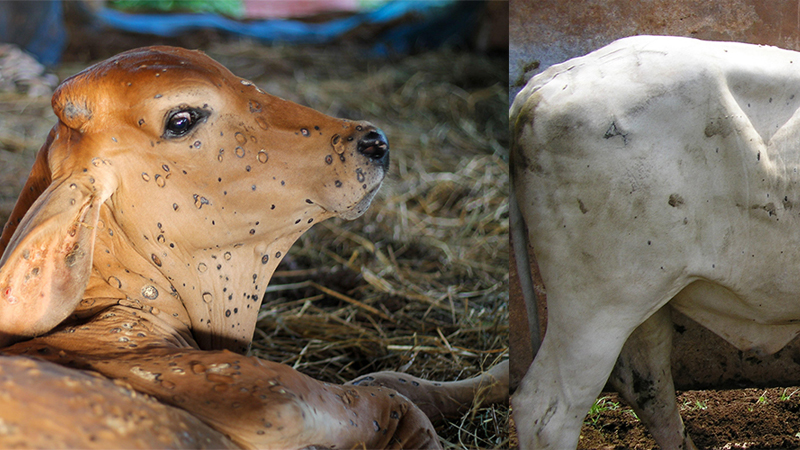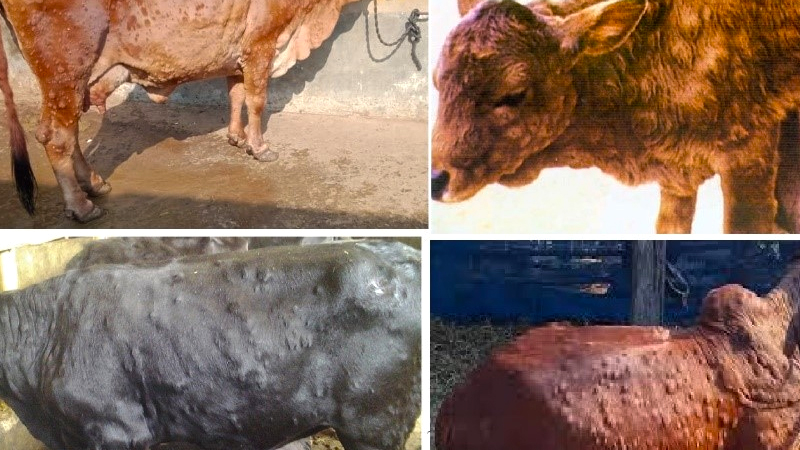What is Lumpy Skin Disease (LSD)?
- Lumpy Skin Disease (LSD) is a viral ailment caused by the Capri poxvirus that has emerged as a global concern to livestock.
- It shares genetics with the goat and sheep pox viruses.
- Lumpy skin disease is an infectious, eruptive, and sometimes lethal disease that causes nodules on the skin and other regions of the body in cattle.
- The illness is frequently aggravated by a secondary bacterial infection.
- Blood-feeding insects are the primary carriers of LSD in cattle and water buffalo.
- It has no effect on other livestock or humans.
- The emergence of round, hard nodes on the animal’s hide is one of the clinical indications.
- They begin to lose weight right after and have a lower milk supply.
Morbidity & Mortality Rate Due to Lumpy skin disease:
- The mortality rate (Death rate) is normally low, with a morbidity (illness) of 5%–50%.
- Reduced milk yield, loss of condition, rejection or reduced value of the hide account for the majority of the losses.
Difference between Lumpy Skin Disease (LSD) & Pseudo Lumpy Skin Disease (PLSD):
- The Capri poxvirus causes Lumpy Skin Disease (LSD), which is a viral illness.
- Herpesvirus-caused pseudo-lumpy skin disorder (bovine herpesvirus 2).
- Pseudo Lumpy Skin Disease is of less clinically important than Lumpy Skin Disease.
- Lumpy Skin Disease is more severe and lethal than Pseudo Lumpy Disease.
- Pseudo-lumpy skin disease is a less severe form of lumpy skin disease than actual lumpy skin disease.

Geographically Spread of Lumpy Skin Disease:
- Lumpy skin disease is traditionally located in southern and eastern Africa, but it spread northwest through the continent in the 1970s, reaching Sub-Saharan West Africa.
- It has spread to various Middle Eastern countries since 2000, and in 2013 it expanded westward into Turkey and several Balkan countries. In Georgia, Russia, Bangladesh, India, the People’s Republic of China, and the Islamic Republic of Pakistan, outbreaks of lumpy skin disease have lately been documented for the first time.
- Lumpy skin condition has recently spread around the globe, causing international worry.
- In the Western hemisphere, as well as Australia and New Zealand, no cases of the disease have been reported.
Nutrition from Cattle affected by Lumpy Skin Disease?
- Lumpy Skin Disease (LSD) of cattle cannot be transmitted to humans and their meat and milk can be used for nutrition, but prevention is better to avoid any dangerous conditions.
How the disease spread/Causes of Lumpy Skin Disease:
- The exact mechanism of LSD transfer is unknown.
- Mechanical transmission through arthropod vectors such as mosquitoes, ticks, and biting flies, as well as movement of infected animals, are the two main methods of transmission.
- Fomites can also spread the disease through contaminated equipment and, in some situations, direct contact between animals.
- The illness has demonstrated its potential to establish and spread in a variety of environmental and industrial systems all over the world.
- Lumpy skin disease can be pandemic or sporadic in nature.
- It is most common during damp summer weather, but it can also happen in the winter. It’s especially common in waterways and in low-lying areas.
- Biting insects are the main carriers of LSD.
- The virus is spread mechanically by insects such as mosquitoes, biting flies, and possibly ticks. It can also be passed from animal to animal by secretions and excretions.
- Contaminated feed, water, vehicles, and iatrogenic methods (such as using needles on different animals repeatedly) can all spread the disease.
- Infected animals’ milk may also contain LSD, which is excreted in their sperm.
Sign & Symptoms of lumpy skin disease in animals:
- Fever, lacrimation, nasal discharge, and hyper salivation occur in 50% of infected cattle, followed by the typical eruptions on the skin and other regions of the body. The length of incubation period is 4–14 days.
- The nodules are well-circumscribed, round, slightly elevated, firm, and painful, with a diameter of up to 50 mm, and they affect the entire cutis as well as the mucosa of the GI, respiratory, and vaginal tracts.
- Skin nodules form around the head, neck, genitals, and limbs. Nodules can form on any area of the body at any time.
- On the muzzle, as well as within the nasal and buccal mucous membranes, nodules can form. A firm, creamy-gray or yellow clump of tissue resides within the skin nodules.
- Edema develops in the udder, brisket, and legs, and regional lymph nodes swell. Secondary infection can arise, resulting in significant suppuration and sloughing, causing the animal to become exceedingly malnourished and necessitating death.
- The nodules retreat over time, or necrosis of the skin causes hard, elevated regions (“sit-fasts”) that are visibly separated from the surrounding skin. These areas flake off, leaving ulcers that heal but leave scars.
- Some others clinical findings are given below:
- Swelling of the limbs, brisket, and genitals may occur, among other clinical signs.
- Tears in the eyes
- Increased secretions in the nose and salivary glands.
- Some animals with the disease may show no signs or symptoms (have the disease but not show signs).
Diagnosis of Lumpy Skin Disease in Cattle:
The disease is sometimes misunderstood for the less serious pseudo-lumpy skin disease, which is caused by a herpesvirus (bovine herpesvirus 2). Clinically, both diseases are identical, albeit in some parts of the world, herpesvirus lesions appear to be limited to cows’ teats and udders, and the condition is known as bovine herpes mammalities.
Histopathology, virus isolation, or PCR:
- Although pseudo-lumpy skin disease is a lesser form of actual lumpy skin disease, it is distinguished by the isolation and/or identification of the causative virus.
- In early skin lesions, electron microscopy can reveal the pox virus that causes lumpy skin disease.
- PCR can tell the difference between the two disorders.
- In cattle, Dermatophilosis congolensis creates skin nodules.
Treatment and Prevention of Lumpy Skin Disease in Cattle:
The recent increase in the incidence of lumpy skin condition is concerning. Following measure are used to control and prevent lumpy skin disease:
- Movement control (quarantine)
- Vaccine
- slaughter campaigns
- management measures
Because national control strategies differ by different country, concerned competent authorities and veterinarians should be consulted for advice.
Vaccination:
- There is no treatment for the virus, so prevention by vaccination is the most effective means of control.
- Vaccination is the most effective means of control, and live homologous vaccines containing a Neethling-like strain of LSDV are recommended.
- Attenuated virus vaccines may help control spread.
Other Preventive Medications:
- Administration of antibiotics to control secondary infection and good nursing care are recommended, but the large number of affected animals within a herd may preclude treatment
- Secondary infections in the skin may be treated with Non-Steroidal Anti-Inflammatory Drugs (NSAIDs) when appropriate.
- Anti-Allergic medicine along Anti-Biotics & NSAIDs are also fruitful in this disease.
Additional Preventive measures:
Some additional preventive measures are follows:
- Ensure proper ticks and biting arthropods control
- Traditional and Ayurvedic Veterinary Medicine can be used to manage the condition.
- LSD eradication is challenging, and early detection is critical for control and eradication success.

